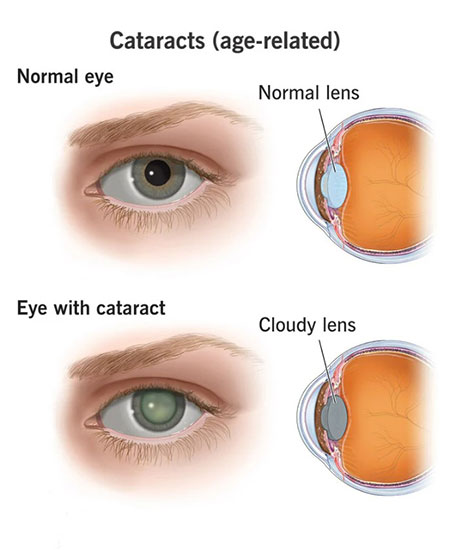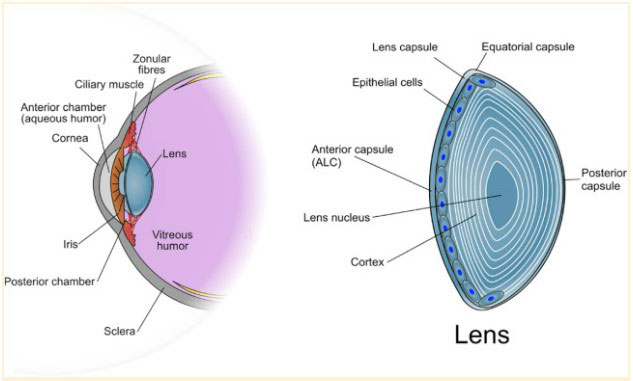 Cataracts are a common eye condition that affects more than 24.4 million Americans over the age of 40. It is a progressive disease that causes clouding of the eye's natural lens, leading to blurred vision, difficulty seeing in low light conditions, and overall visual impairment. This article will provide a comprehensive overview of cataracts, including their symptoms, diagnosis, and treatment options.
Cataracts are a common eye condition that affects more than 24.4 million Americans over the age of 40. It is a progressive disease that causes clouding of the eye's natural lens, leading to blurred vision, difficulty seeing in low light conditions, and overall visual impairment. This article will provide a comprehensive overview of cataracts, including their symptoms, diagnosis, and treatment options.
Understanding Cataracts
Cataracts are a common vision disorder when the proteins in the eye's natural lens clump together, leading to cloudiness. This cloudiness can worsen over time, causing progressive vision loss and difficulty performing daily activities such as reading, driving, or watching TV.
Cataracts can affect one or both eyes and are more prevalent in older adults, with nearly half of all Americans aged 80 or older having cataracts. Research studies have shown that cataract surgery is a safe and effective treatment, with an overall success rate of approximately 95%.
Types of Cataracts:
Pediatric Cataracts:
Pediatric cataracts impact infants and young children. These cataracts can either be present at birth (congenital) or develop later on. Pediatric cataracts can result from genetic factors, eye injuries, and other eye-related conditions. Children with pediatric cataracts require immediate medical attention to avoid complications such as amblyopia, commonly known as lazy eye.
Traumatic Cataracts:
Traumatic cataracts result from eye injury caused by a blunt force or foreign object, accounting for about 8% of all cataract cases. Treating this type of cataract can be challenging, as the surrounding structures may also require repair. Research studies have shown that early surgical intervention for traumatic cataracts can improve patients' visual outcomes and quality of life.
Age-related Cataracts:
Age-related cataracts have distinct types based on their location in the lens. The three types of cataracts are nuclear, cortical, and posterior subcapsular cataracts. Familiarizing oneself with lens anatomy can help comprehend these types, which may cause different symptoms and require distinct treatment approaches.
Cataracts are classified based on the location of their formation within the lens. It is common for individuals to have more than one type of cataract simultaneously, as cloudy patches can develop in multiple areas of the lens.

The three most common age-related cataract types are:
- Nuclear sclerotic cataract forms in the nucleus.
- Cortical cataract, which originates in the cortex.
- Posterior subcapsular cataract: forms in the back of the lens cortex, closest to the retina.
Symptoms of Cataracts
The symptoms of cataracts can vary depending on the severity of the condition. Early symptoms may include:
- Blurred or cloudy vision
- Difficulty seeing at night
- Sensitivity to light
- Halos or glares around lights
- Colors appearing faded or yellowed
As cataracts progress, symptoms may worsen, and patients may experience the following:
- Double vision in one eye
- Vision loss that is not correctable with glasses or contacts.
- Needing brighter light for reading or performing other tasks
- Difficulty distinguishing shapes and colors
- Changes in the way you perceive depth
Diagnosing Cataracts
If you are experiencing symptoms of cataracts, seeking medical attention is essential. Your eye doctor will perform a comprehensive eye exam to diagnose cataracts. This exam may include the following:
- Visual acuity test: to measure how well you can see at different distances
- Dilated eye exam: examines the back of your eye
- Slit-lamp examination: to examine the front of your eye
- Retinal examination: to examine the back of your retina
If your optometrist diagnoses you with cataracts, they will work with you to develop a treatment plan based on the severity of the condition.
Treating Cataracts
The only way to treat cataracts is surgery to remove the cloudy lens and replace it with an artificial one. Every year, over 3 million people in the United States undergo cataract surgery, making it one of the most routinely performed surgeries with high success rates of approximately 98%.
When undergoing cataract surgery, the ophthalmologist will make a small incision in your eye and utilize ultrasound technology to break up the cloudy lens. The fragments will be carefully removed and replaced with an artificial lens designed to restore your vision. Following the procedure, you may need to wear an eye patch for a brief period, avoid activities that could strain your eyes, and use prescribed eye drops to minimize the likelihood of infection and inflammation.
Remember that your healthcare provider will be there to guide you through the process and answer any questions you may have.
How To Prevent Cataracts
Here are a few steps you can take to reduce your risk of developing cataracts:
- Protect your eyes from UV rays by wearing polarized sunglasses or a wide-brimmed hat
- Stop smoking
- Follow a healthier diet
- Get regular eye exams
Living with cataracts can be challenging, but there are steps you can take to manage the condition, including:
- Use brighter lightbulbs for reading
- Avoid driving at night if headlights cause eye discomfort or glare on the road.
- Manage any underlying conditions that could aggravate symptoms.
Cataracts are a common eye disease that can cause visual impairment and discomfort. Early diagnosis and treatment can prevent vision loss. It would help to discuss it with your ophthalmologist to find the right timing should you require surgery.
